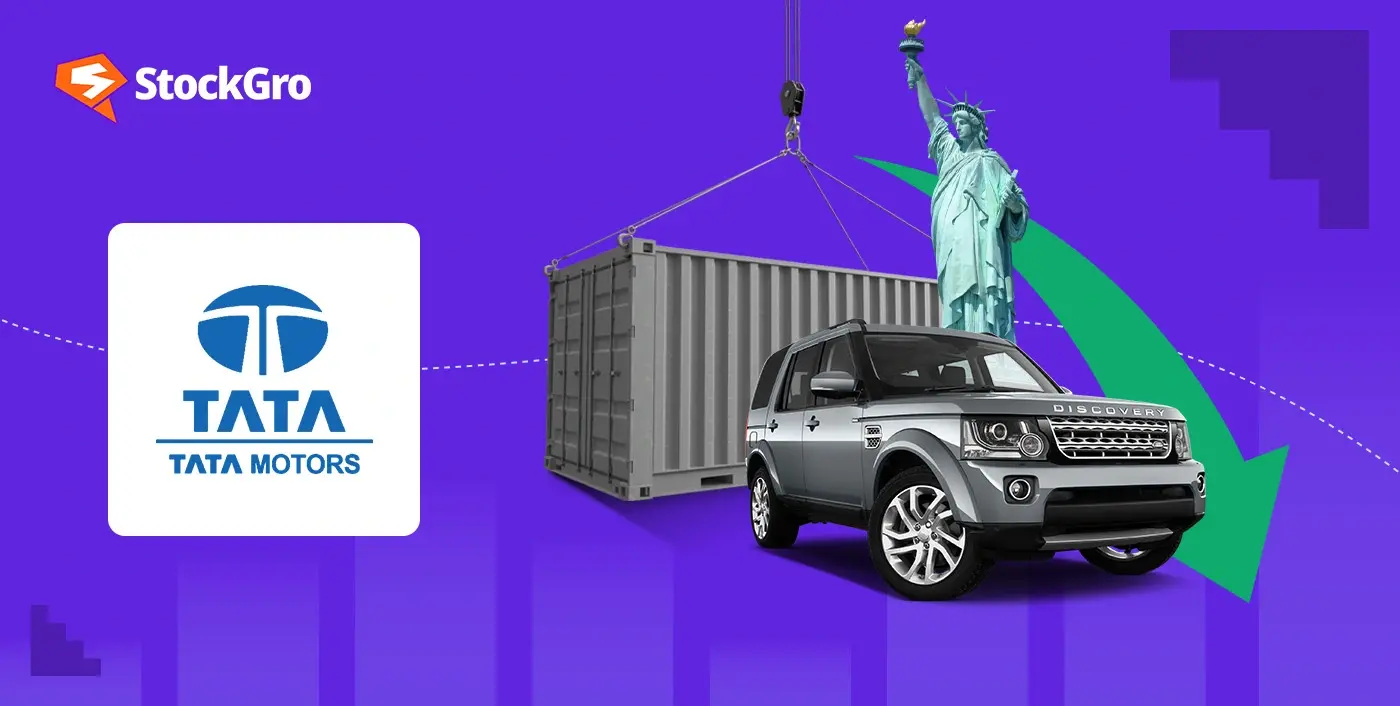
On April 7, 2025, Tata Motors saw its shares plunge nearly 12%, hitting a new 52-week low of ₹542.55. What caused this? A simple yet high-stakes announcement: Jaguar Land Rover (JLR), Tata Motors’ UK-based subsidiary, temporarily paused shipments to the US for April.
Why? A 25% tariff was imposed on all imported vehicles by the Trump administration in the US.
JLR ships 100% of its US inventory from outside the country. It has no local manufacturing units in America. This means every car it sells in the US is subject to full import duties, making a sudden 25% tariff a major blow to both pricing and profitability.
Breaking down the market impact
The effect on the Tata Motors share price was instant and severe:
| Metric | Value |
| Opening Price (April 7, 2025) | ₹552.50 |
| Day’s Low | ₹542.55 (52-week low) |
| Intra-day Recovery | ₹559.75 (down 8.8%) |
| Market Cap Post-Fall | ₹2,25,979 crore |
| YTD Price Drop | 18% |
| 12-Month Price Drop | 39% |
| 5-Day Price Drop | 17.12% |
| 6-Month Price Drop | 39.42% |
| 1-Year Price Drop | 44.50% |
Tata Motors was the worst-performing stock on the Nifty 50 today.
JLR’s dependency on the US market
In the last quarter of 2024 alone, JLR exported 38,000 vehicles to the US. That’s no small number, especially when you consider that the US contributes to nearly one-third of JLR’s global volumes.
JLR accounts for two-thirds of Tata Motors’ overall revenue, so anything that disrupts JLR’s US performance directly affects Tata Motors’ balance sheet.
Also read: Tata Motors share analysis – StockGro
The company’s official response
JLR released a carefully worded statement:
“The USA is an important market for JLR’s luxury brands. As we work to address the new trading terms with our business partners, we are enacting our short-term actions, including a shipment pause in April, as we develop our mid- to longer-term plans.”
In plain terms: this is a temporary pause, not a permanent exit, but markets rarely wait for long-term plans.
Brokerage response and valuation cuts
In response to this development, international brokerage CLSA downgraded Tata Motors’ rating from ‘high-conviction outperform’ to ‘outperform’ and slashed its target price from ₹930 to ₹765.
HSBC warned of a potential 14% YoY drop in JLR volumes by FY26 due to this tariff shock, compounded by:
- Increasing competition from Chinese OEMs
- Regulatory uncertainties in Europe
- Lower industry-wide growth expectations
They also noted a 6% decrease in average US vehicle incentives for JLR in Q3 FY25, now at $4,074 per car.
You may also read: Nykaa shares drop despite healthy Q4 FY25 revenue growth outlook
Sales numbers
The shipment halt wasn’t the only worry. Tata Motors also released its March 2025 sales update and it didn’t help boost investor confidence.
| Category | March FY25 | Change YoY |
| Total Domestic Sales | 90,500 units | -0.3% |
| Passenger Vehicles (incl. EVs) | 51,872 units | +3% |
| Commercial Vehicles | 41,122 units | -3% |
For FY25, Tata Motors’ domestic performance also declined:
| Category | FY25 | Change |
| Total Domestic Sales | 9,12,155 units | -4% |
| Passenger Vehicles | 5,56,263 units | -3% |
| Commercial Vehicles | 3,76,903 units | -5% |
So even if JLR had held steady, the domestic slowdown was already a concern.
What are analysts saying now?
Despite the rough patch, many analysts are still backing Tata Motors for the long run.
| Metric | Value |
| Analyst Consensus | 30 analysts say ‘Buy’ |
| Average Target Price | ₹843 |
| Upside from ₹559.75 | 37% |
This optimism stems from the company’s broader EV roadmap, JLR’s brand value in international markets, and long-term potential despite short-term headwinds.
You may also read: Dabur India share price drops 7% to 52-week low after Q4 update
Should you panic if you’re holding Tata Motors?
Yes, the Tata Motors share price has fallen steeply—nearly 45% over the last year. But here’s what you should really watch:
- Whether JLR extends the US shipment pause beyond April
- How long will the 25% US auto tariff remain in place
- Domestic sales recovery across PV and CV categories
- Fresh announcements from the company on cost-cutting or localisation strategies
Markets don’t like surprises, but they also reward companies that act fast. If JLR finds an effective workaround, or if tariffs ease post-US elections, there’s still upside on the table.
Final thoughts
This isn’t the first external shock Tata Motors has faced—and it won’t be the last. What matters now is how fast they adapt.
While the immediate hit to the Tata Motors share price is real and painful, long-term investors might want to keep their eyes on how the company handles this crisis. As history has shown, Tata Motors has bounced back before.
Lesson? Volatility may be temporary, but resilience pays off—if you can stay patient.

